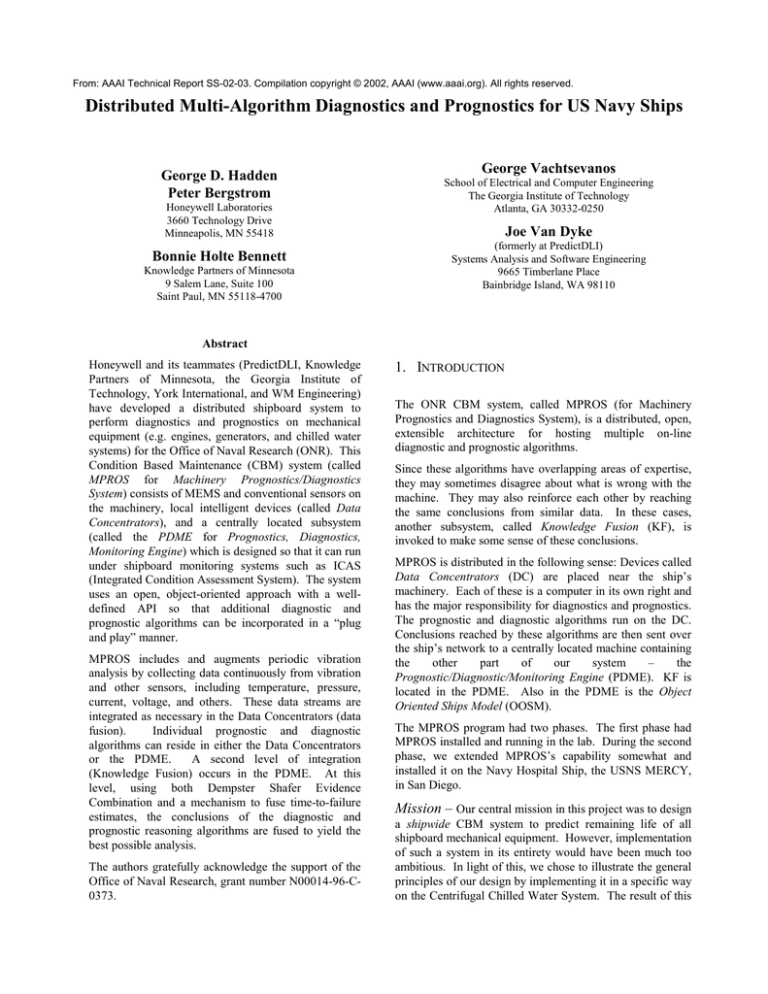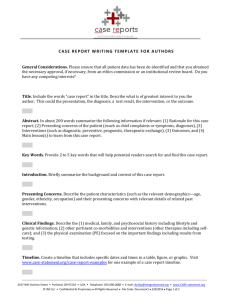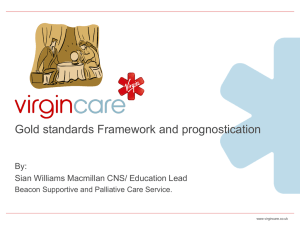
From: AAAI Technical Report SS-02-03. Compilation copyright © 2002, AAAI (www.aaai.org). All rights reserved.
Distributed Multi-Algorithm Diagnostics and Prognostics for US Navy Ships
George D. Hadden
Peter Bergstrom
Honeywell Laboratories
3660 Technology Drive
Minneapolis, MN 55418
Bonnie Holte Bennett
Knowledge Partners of Minnesota
9 Salem Lane, Suite 100
Saint Paul, MN 55118-4700
George Vachtsevanos
School of Electrical and Computer Engineering
The Georgia Institute of Technology
Atlanta, GA 30332-0250
Joe Van Dyke
(formerly at PredictDLI)
Systems Analysis and Software Engineering
9665 Timberlane Place
Bainbridge Island, WA 98110
Abstract
Honeywell and its teammates (PredictDLI, Knowledge
Partners of Minnesota, the Georgia Institute of
Technology, York International, and WM Engineering)
have developed a distributed shipboard system to
perform diagnostics and prognostics on mechanical
equipment (e.g. engines, generators, and chilled water
systems) for the Office of Naval Research (ONR). This
Condition Based Maintenance (CBM) system (called
MPROS for Machinery Prognostics/Diagnostics
System) consists of MEMS and conventional sensors on
the machinery, local intelligent devices (called Data
Concentrators), and a centrally located subsystem
(called the PDME for Prognostics, Diagnostics,
Monitoring Engine) which is designed so that it can run
under shipboard monitoring systems such as ICAS
(Integrated Condition Assessment System). The system
uses an open, object-oriented approach with a welldefined API so that additional diagnostic and
prognostic algorithms can be incorporated in a “plug
and play” manner.
MPROS includes and augments periodic vibration
analysis by collecting data continuously from vibration
and other sensors, including temperature, pressure,
current, voltage, and others. These data streams are
integrated as necessary in the Data Concentrators (data
fusion).
Individual prognostic and diagnostic
algorithms can reside in either the Data Concentrators
or the PDME.
A second level of integration
(Knowledge Fusion) occurs in the PDME. At this
level, using both Dempster Shafer Evidence
Combination and a mechanism to fuse time-to-failure
estimates, the conclusions of the diagnostic and
prognostic reasoning algorithms are fused to yield the
best possible analysis.
The authors gratefully acknowledge the support of the
Office of Naval Research, grant number N00014-96-C0373.
1. INTRODUCTION
The ONR CBM system, called MPROS (for Machinery
Prognostics and Diagnostics System), is a distributed, open,
extensible architecture for hosting multiple on-line
diagnostic and prognostic algorithms.
Since these algorithms have overlapping areas of expertise,
they may sometimes disagree about what is wrong with the
machine. They may also reinforce each other by reaching
the same conclusions from similar data. In these cases,
another subsystem, called Knowledge Fusion (KF), is
invoked to make some sense of these conclusions.
MPROS is distributed in the following sense: Devices called
Data Concentrators (DC) are placed near the ship’s
machinery. Each of these is a computer in its own right and
has the major responsibility for diagnostics and prognostics.
The prognostic and diagnostic algorithms run on the DC.
Conclusions reached by these algorithms are then sent over
the ship’s network to a centrally located machine containing
the
other
part
of
our
system
–
the
Prognostic/Diagnostic/Monitoring Engine (PDME). KF is
located in the PDME. Also in the PDME is the Object
Oriented Ships Model (OOSM).
The MPROS program had two phases. The first phase had
MPROS installed and running in the lab. During the second
phase, we extended MPROS’s capability somewhat and
installed it on the Navy Hospital Ship, the USNS MERCY,
in San Diego.
Mission – Our central mission in this project was to design
a shipwide CBM system to predict remaining life of all
shipboard mechanical equipment. However, implementation
of such a system in its entirety would have been much too
ambitious. In light of this, we chose to illustrate the general
principles of our design by implementing it in a specific way
on the Centrifugal Chilled Water System. The result of this
Ship’s Network
DC
DC
PC
PDME
DCOM Interface
Executive
DCOM Interface
DLI
Expert
System
SBFR
Wavelet
Neural
Network
Fuzzy
Logic
OO
Ship
Model
KF
Database
Control
signals
MUX
Data
Acquisition
Card
PDME
Resident
Algorithms
User
Interface
MUX
Machinery Sensors
Figure 1 The MPROS System
philosophy is that occasionally we chose a more general way
of solving a problem over a “centrifugal chiller-specific”
solution.
Why Centrifugals? – There were two main reasons for
our choice of centrifugal chillers: System complexity and
commercial applicability. These A/C systems combine
several rotating machinery equipment types (i.e. induction
motors, gear transmissions, pumps, and centrifugal
compressors) with a fluid power cycle to form a complex
system with several different parameters to monitor. This
dictated the requirement for a correspondingly complex and
versatile monitoring system. Dynamic vibration signals
must be acquired using high sampling rates and complex
spectrum and waveform analysis.
Slower changing
parameters such as temperatures and pressures must also be
monitored, but at a lower frequency and can be treated as
scalars rather than vectors as with vibration spectra. All of
these monitored parameters and analysis techniques are
combined using a versatile diagnostic system. The final
product has the inherent capability of diagnosing not just the
whole A/C system, but each of its parts as well, making it a
potentially very useful tool for monitoring any pump, motor,
gearset, or centrifugal compressor in the fleet.
Secondly, the selection of A/C system as the subject will
provide a high probability of commercial applicability of the
resultant monitoring system. There are a great deal of
facilities industrial, military, commercial, and institutional
that use large centrifugal chiller based A/C systems
throughout the US and the world.
2. SOFTWARE
Figure 1 shows a diagram of the MPROS system. Here we
describe the various parts.
PDME Software
The Prognostic, Diagnostic, Monitoring Engine (PDME) is
the logical center of the MPROS system. Diagnostic and
prognostic conclusions are collected from DC-resident
Database Mapping.
Figure 2 MPROS User Interface
algorithms as well as PDME-resident algorithms. Fusion of
conflicting and reinforcing source conclusions is performed
to form a prioritized list for the use of maintenance
personnel.
The PDME is implemented on a Windows NT platform as a
set of communicating servers built using Microsoft’s
Component Object Model (COM) libraries and services.
Choosing COM as the interface design technique has
allowed us to build some components in C++ and others in
Visual Basic, with an expected improvement in development
productivity as the outcome. Some components were
prototyped using Microsoft Excel and we continue to use
Excel worksheets and macros to drive some testing of the
system. Communications between DC components and
PDME components depend on Distributed COM (DCOM)
services built into Microsoft’s operating systems.
User interface – As shown in Figure 2, an interface to the
MPROS conclusions has been built. The sample screen
shown indicates that for machine A/C Compressor Motor 1,
six condition reports from four different knowledge sources
(expert systems) have been received, some conflicting and
some reinforcing.
After these reports are processed by the Knowledge Fusion
component, the predictions of failure for each machine
condition group are shown at the bottom of the screen.
This display is updated as new reports arrive at the PDME
and are accumulated in the OOSM.
Object Oriented Ship Model – Entities in the OOSM
are modeled as objects with properties and relationships to
other entities. Some of the OOSM objects represent
physical entities such as sensors, motors, compressors,
decks, and ships while other OOSM objects represent more
abstract items such as a failure prediction report or a
knowledge source. Some common properties include name,
manufacturer, energy usage, capacity, and location.
Common relationships include part-of, kind-of, connectedto, and energy flow.
Diagnostic and prognostic conclusions are stored in the
OOSM – both those of the individual algorithms and those
reached by KF. It also serves as blackboard by providing a
means of communication among the individual algorithms.
Knowledge Fusion – Knowledge fusion is the
coordination of individual data reports from a variety of
sensors. It is higher level than pure “data fusion” which
generally seeks to correlate common-platform data.
Knowledge fusion, for example, seeks to integrate reports
from acoustic, vibration, oil analysis, and other sources, and
eventually to incorporate trend data, histories, and other
components necessary for true prognostics.
The knowledge fusion components must be able to
accommodate inputs that are incomplete, time-disordered,
fragmentary, and that have gaps, inconsistencies, and
contradictions. In addition, knowledge fusion components
must be able to collate, compare, integrate, and interpret
data from a variety of sources. To do this, it must provide
both inference control that accommodates a variety of input
data and fusion algorithms with the ability to deal with
disparate inputs.
Knowledge fusion follows this procedure:
1.
New reports arriving to the PDME are posted in the
OOSM.
2.
New reports posted in the OOSM generate “new data”
messages to the knowledge fusion components.
3.
The knowledge fusion components access the newly
arrived data from the OOSM. They perform knowledge
fusion of diagnostic reports and knowledge fusion of
prognostic reports.
4.
Conclusions from the knowledge fusion components are
posted to the OOSM and presented in user displays in
the graphical user interface.
To date, two levels of knowledge fusion have been
implemented: one for diagnostics and an extension for
prognostics (remaining life).
Our approach for implementing knowledge fusion for
diagnostics uses Dempster-Shafer belief maintenance for
correlating incoming reports. This is facilitated by use of a
heuristic that groups similar failures into logical groups.
Dempster-Shafer theory is a calculus for qualifying beliefs
using numerical expressions. For example, given a belief of
40% that A will occur and another belief of 75% that B or C
will occur, it will conclude that A is 14% likely, B or C is
64% likely, and assign 22% of belief to unknown
possibilities.
This maintenance of the likelihood of
unknown possibilities is both a differentiator and a strength
of Dempster-Shafer theory. It was chosen over other
approaches (e.g., Bayes nets) because the others require
prior estimates of the conditional probability relating two
failures – data not yet available for the shipboard domain.
The system was augmented by heuristically collecting
similar failures into logical groups.
This facilitates
processing and streamlines operation because DempsterShafer analysis looks at each failure in light of every other
possible failure and is required to produce the likelihood of
unknown possibilities.
In the MPROS case, this is
inadequate because it would assume mutual exclusivity of
failures. However, this is not a realistic assumption. There
can, in fact, be several failures at one time, and two or more
of them might be independent of one another. Thus, we
developed the concept of logical groups of failures. Failures
that are all part of the same logical groups are related to
each other (for example, one group might be electrical
failures, while another group would be lubricant failures,
etc.). Moreover, failures within a group might be mistaken
for one another, so any two of them are logically related and
should share probabilities when they are both under
consideration. Note that this does not preclude multiple
failures within a group all being suspected concurrently; it
simply ensures that they are tracked and weighted correctly.
The second level of knowledge fusion combines time to
failure estimates. Time to failure is represented in our
system as a list of one or more time points, probability pairs,
called the ‘prognostic vector’. For example, the prognostic
vector with the single member ‘((3 months, .1))’ indicates
that the system has a 10% likelihood of failure within 3
months. The prognostic vector ‘((2 weeks, .1) (1 month, .5)
(2 months, .9))’ indicates a likelihood of failure of 10%
within 2 weeks, 50% within 1 month, and 90% within 2
months.
Our approach to the fusion of prognostics information is to
combine the lists, taking the most conservative estimate at
any given time period, interpolating a smooth curve from
point to point, and extrapolating the worse case from the
entry with the longest interval. For example, suppose we
have a prognostic for a given component that indicates it
will perform well for 3 months, and then experience some
trouble making it as likely to fail as not by 4 months and
almost surely to fail within 5 months. The prognostic vector
for this case is ((3 months, .01) (4 months, .5) (5 months,
.99)). Suppose further that we need to combine this with
another report showing that the same component will
experience some small trouble at 4-1/2 months. This
prognostic vector is ((4.5 months, .12)). Under our current
approach, we ignore the second report and stick with the
first, which is more conservative. If, however, the second
report indicates a much higher likelihood of failure, say
((4.5 months, .95)), then this report would dominate and the
extrapolation of the curve beyond this point would indicate
an even earlier demise of the component than the first
prognostic vector.
Interfaces provided. One of the goals of the MPROS
system is to encourage the incorporation of the appropriate
set of algorithms supplying diagnostic and prognostic
conclusions based on similar, overlapping, or entirely
disjoint sensor readings. At the same time, we recognized
that these diverse results must be unified into a meaningful
report to the system’s users. To this end, a standard protocol
has been defined for reporting failure predictions to the
PDME for fusion and display.
The general incoming report format may contain the
following data fields (not all reports need use all fields):
1.
KnowledgeSourceID: The unique MPROS object ID
for the instance of the diagnostic/prognostic algorithm
generating the report.
2.
SensedObjectID: The unique MPROS object ID for the
sensed object to which this report applies.
3.
MachineConditionID: The unique MPROS object ID
for the diagnosed machine condition (usually a failure
mode).
4.
Severity: Numeric value in the range 0.0 to 1.0
indicating relative severity of machine condition to
operation. Maximal severity is 1.0.
5.
Belief: Numeric value in the range 0.0 to 1.0 indicating
belief that this diagnosis is true. Maximal belief is 1.0.
6.
Explanation: An optional text string providing a humanreadable description of the diagnosis.
7.
Recommendations: An optional text string providing a
human-readable description of the recommended
actions to take.
8.
Timestamp: The timestamp for when this report should
be considered effective.
9.
Additional Information: An optional text string
providing human-readable additional information.
10. Prognostic vector: A vector of time point, probability
pairs indicating projected likelihood of failure (as
described above).
Diagnostic knowledge fusion generates a new fused belief
whenever a diagnostic report arrives for a suspect
component. This updates the belief for that suspect
component and for every other failure in the logical group
for that component. It also updates the belief of ‘unknown’
failure for the logical group for that component.
Prognostic knowledge fusion generates a new prognostic
vector for each suspect component whenever a new
prognostic report arrives.
Future directions for knowledge fusion. Several highlevel control extensions are under consideration for future
extensions. First, multilevel data are represented by the
OOSM. We are not currently exploiting this fully. For
example, we could reason about the health of a system based
on the health of a constituent part. Currently, only the parts
are tracked. Second, spatial reasoning using the OOSM
could lead us to fuse information about spatially related
components. One example of a spatial relation is proximity.
For example, a device might be vibrating because a
component next to it is broken and vibrating wildly. Another
example is flow. Flows are relationships that represent fluid
flow through the system (one component passing fouled
fluids on to other components downstream), electrical flow,
or mechanical flow of physical energy. Third, temporal
reasoning components could be implemented to scrutinize
failure histories and provide better projections of future
faults as they develop.
Two other future directions for knowledge fusion are the
refinement of specific knowledge fusion components for
diagnostics and for prognostics. For example, Bayes nets
seem to be a promising approach to diagnostic knowledge
fusion when causal relations and a priori relationships can
be teased out of historical data. Prognostic knowledge
fusion could be improved with the addition of techniques
from the analysis of hazard and survival data. These
approaches scrutinize history data to refine the estimates of
life-cycle performance for failures, and the refined inputs to
the prognostic analysis should yield better projections of
future failures.
Resident Algorithms – As the reader can see from
Figure 1, the PDME has the capability to host prognostic
and diagnostic algorithms. Some reasons for placing the
algorithms in the PDME rather than the DC include: the
algorithm requires data from widely separate parts of the
ship, the algorithm can reason from PDME resident
components (a model-based diagnostic and prognostic
system, for instance, might use only the OOSM), and so on.
Although we provide this capability in our general
architecture, our system as currently implemented does not
place any diagnostic/prognostic algorithms in the PDME –
all of them run in the data concentrators.
Data Concentrator (DC) Software
Scheduler – At the heart of the DC software is an event
scheduler. This software component runs the show by
organizing all necessary events. For example, the standard
vibration test and analysis is executed routinely by the
scheduler. To do a standard vibration test, the scheduler
first triggers execution of vibration data acquisition
component, and when that operation is complete the
scheduler fires off the vibration analysis component and then
triggers communication of the results. In similar fashion, the
scheduler conducts wavelet and neural network testing and
analysis and state based feature recognition and fuzzy logic
routines to collect and analyze process variables.
Each of the components extracts information from and store
data in the DC database, which is configured as a database
server and can be accessed by client PC’s on the network.
In this way, the PDME or any other client can command the
scheduler to conduct another test and analysis routine.
Data Base – Central to the operation of the DC is an open
architecture ODBC compliant relational database designed
to store all of the instrumentation configuration information,
machinery configuration information, test schedules,
resultant measurements, diagnostic results, and condition
reports. The database design is a commercially available
database already field tested and proven effective in many
industrial facilities.
Prognostic/Diagnostic Algorithms – The current
version of MPROS has four sets of prognostic/diagnostic
algorithms: the PredictDLI Expert System, Wavelet Neural
Networks, Fuzzy Logic, and State Based Feature
Recognition. A brief description of each of these follows:
PredictDLI’s (a company in Bainbridge Island, Washington
that has a Navy contract to do CBM on shipboard
machinery) vibration based expert system has been adapted
to run in a continuous mode. These algorithms excel when
the Chiller is performing in steady state.
Wavelet-Neural Network (WNN) diagnostics and
prognostics developed by Professor George Vachtsevanos
and his colleagues at Georgia Tech. This technique is, like
PredictDLI’s, aimed at vibration data, however,
complementing the PredictDLI algorithm, their algorithm
excels at drawing conclusions from transitory phenomena
rather than steady state data.
Fuzzy Logic diagnostics and prognostics also developed by
Georgia Tech which draws diagnostic and prognostic
conclusions from non-vibrational data.
State Based Feature Recognition (SBFR), a Honeywelldeveloped embeddable technique that facilitates recognition
of time-correlated events in multiple data streams.
Originally developed for Space Station Freedom, this
technique has been used in a number of NASA related
programs.
3. VALIDATION
One question we are often asked is “How are you going to
prove that your system does what you say it does?” This
question, as it turns out, is a quite difficult one. The
problem is that we are developing a system that we claim
will predict failures in devices, and that in real life, these
devices fail relatively rarely. In fact, for any one failure
mode, it is entirely possible that the failure mode (although
valid) may never have occurred on any piece of equipment
on any ship in the fleet! We have a number of answers to
the question:
•
•
•
•
We are still going to look for the failure modes. We
have a number of installed data collectors both on land
and on ships. In addition, PredictDLI is collecting time
domain data for a number of parameters whenever their
vibration-based expert system predicts a failure on
shipboard chillers. This will give us data that we can
use to test our system.
As Honeywell upgrades its air conditioning systems to
be compliant with new non-polluting refrigerant
regulations, older chillers become obsolete. We have
managed to acquire one of these chillers that Honeywell
replaced. It was shipped to York, and we have
completed a program to collect data from this chiller
through a carefully choreographed set of destructive
tests.
Seeded faults are worth doing. Our partners in the
Mechanical Engineering Department of Georgia Tech
are seeding faults in bearings and collecting the data.
These tests have the drawback that they might not
exhibit the same precursors as real-world failures,
especially in the case of accelerated tests.
Honeywell, York, PredictDLI, NRL, and WM
Engineering have archives of maintenance data that we
will take full advantage of in constructing our
prognostic and diagnostic models.
•
Similarly, these partners have human expertise that we
are able to tap in building our models.
Although persuasive, these answers are far from conclusive.
The authors would welcome any input on further validation
of a failure prediction system.
4. MERCY INSTALLATION
Our system is complete and has been installed in two places:
in the basement of Honeywell Laboratories on a Carrier
19DK chiller and in San Diego on the USNS MERCY’s (TAH-019) #1 AC plant – a York 363 Ton chiller. The system
has detected and reported a number of problems including a
bad bearing on one of the seawater pumps. MPROS also
diagnosed a problem on one of the chilled water pumps that
led to the discovery of a previously unknown failure mode –
an electrical path through the bearings that led to pitting.
The Mercy was chosen for a number of reasons:
1.
It is in a climate that was more likely to require cooling
during the winter shipboard test phase of our centrifugal
chiller prognostics and diagnostics system.
2.
It was likely to stay stationary and not put out to sea (as,
for instance, a carrier would).
3.
It contains pieces of equipment that are the target of our
prognostics and diagnostics efforts.
4.
We have a good working relationship with the crew.
Earlier versions of our system were installed on the
following ships: the USNS COMFORT (T-AH-020), the
USS CONSTELLATION (CV-64), and the USS
ABRAHAM LINCOLN (CVN-72).
5. BIBLIOGRAPHY
Bennett, B.H. and Hadden, G.D. (1999) Condition-based
maintenance: algorithms and applications for embedded
high performance computing. Proceedings of the 4th
International Workshop on Embedded HPC Systems and
Applications (EHPC’99).
Bristow, J., Hadden, G.D., Busch, D., Wrest, D., Kramer,
K., Schoess, J., Menon, S., Lewis, S. and Gibson, P. (1999)
Integrated diagnostics and prognostics systems. Proceedings
of the 53rd Meeting of the Society for Machinery Failure
Prevention Technology (invited).
Echauz, J. and Vachtsevanos, G. (1996) Elliptic and radial
wavelet neural networks. Proceedings of the 2nd World
Automation Congress, Montpellier, France, May 27–30.
Edwards, T.G. and Hadden, G.D. (1997) An autonomous
diagnostic/prognostic system for shipboard chilled water
plants. Proceedings of the 51st Meeting of the Society for
Machinery Failure Prevention Technology.
Hadden, G.D., Bennett, B.H., Bergstrom, P., Vachtsevanos,
G. and Van Dyke, J. (1999) Machinery diagnostics and
prognostics/condition based maintenance: a progress report.
Proceedings of the 53rd Meeting of the Society for
Machinery Failure Prevention Technology.
Hadden, G.D., Bennett, B.H., Bergstrom, P., Vachtsevanos,
G. and Van Dyke, J. (1999) Shipboard machinery
diagnostics and prognostics/condition based maintenance: a
progress report. Proceedings of the 1999 Maintenance and
Reliability Conference (MARCON99).
Hadden, G.D., Edwards, T.G. and Van Dyke, J. (1998)
Shipboard machinery condition based maintenance.
Proceedings of the Maintenance and Reliability Conference
(MARCON98).
Hadden, G.D., Edwards, T.G. and Van Dyke, J. (1996)
Condition based maintenance for shipboard machinery.
Proceedings of the 67th Shock and Vibration Symposium.
Hadden, G.D., Nelson, K.S. and Edwards, T. (1994). Statebased feature recognition. Proceedings of the 17th Annual
AAS Guidance and Control Conference.
Kang, H., Cheng, J., Kim, I. and Vachtsevanos, G. (1991)
An application of fuzzy logic and Dempster-Shafer theory to
failure detection and identification. Proceedings of the 30th
IEEE Conference on Decision and Control, Brighton,
England, 1555–1560.
Mufti, M. and Vachtsevanos, G. (1995) An intelligent
approach to fault detection and identification. Proceedings
of the American Control Conference.
Nelson, K.S. and Hadden, G.D. (1994) Real-time feature
recognition in medical data. Proceedings of the AAAI 1994
Spring Symposium, Artificial Intelligence in Medicine.
Vachtsevanos, G., Kang, H., Cheng, J. and Kim, I. (1992)
On the detection and identification of axial flow compressor
instabilities. American Institute of Aeronautics and
Astronautics, Journal of Guidance, Control, and Dynamics,
15(5), 1216–1223.
George D. Hadden is a Senior
Research
Fellow
at
the
Honeywell Laboratories and a
recipient of the H. W. Sweatt
award – Honeywell's highest
technical honor – for a
preventive maintenance expert
system.
He also serves as
adjunct faculty at the University
of Minnesota where he occasionally teaches a course on
Advanced Artificial Intelligence Programming. Currently,
he is principal investigator of a project to perform condition
based maintenance on Jet Engines. Dr. Hadden received his
Ph.D. and Masters Degree in Electrical Engineering from
the University of Illinois where he specialized in the study of
Artificial Intelligence and his Bachelors Degree in Electrical
Engineering from Purdue University. He has published over
thirty-five technical papers and has been invited to give
several presentations.
Peter Bergstrom is a Principal
Research Scientist in the Software
Tools Group at the Honeywell
Laboratories in Minneapolis, MN.
He is active in research and
development in System Health
Management. He received his
B.A. in Computer Science from
Macalester College in St. Paul,
Minnesota.
Since
joining
Honeywell Laboratories in 1991, he has developed
applications in Honeywell's avionics, industrial, building
and home control business units.
Bonnie Holte Bennett is an
Associate Professor in the
Graduate Programs in Software
at the University of St. Thomas in
St. Paul, Minnesota. She is the
founder and director of the
Artificial
Intelligence/High
Performance
and
Parallel
Computing Lab. She is also a
principal
with
Knowledge
Partners of Minnesota, Inc.
(www.kpmi.com). She consults extensively with Fortune
200 companies in the areas of knowledge-based systems and
knowledge management. Previously, she spent 14 years at
Honeywell Laboratories in Minneapolis, Minnesota. She
holds Ph.D. and M.S. degrees in Computer Science from the
University of Minnesota, and a Bachelors degree in
Computer Science and English from the College of St.
Thomas.
George
Vachtsevanos
is
Professor
of
Electrical
Engineering at the School of
Electrical
and
Computer
Engineering of the Georgia
Institute of Technology. He
received the BEE degree from
the City College of New York,
the MEE degree from New
York University and a Ph.D.
degree in EE from the City
University of New York. He is
directing the Intelligent Control Systems laboratory at
Georgia Tech and teaches courses and conducts research in
intelligent systems, fuzzy logic and neural networks,
diagnostics and prognostics and manufacturing systems. His
R&D activities are sponsored by industry and government
agencies. He has published over 250 technical papers in his
area of expertise and is the inventor or co-inventor of six
U.S. patents. He is a senior member of IEEE and has
chaired the Association for Electronics Manufacturing
Board of Advisors of SME. He serves as the associate
editor of the International Journal of Intelligent and Robotic
Systems.
Joe Van Dyke, formerly of
PredictDLI, has been involved
in the predictive maintenance
field for 13 years managing
software development projects,
teaching machinery vibration
analysis, and performing a
broad range of mechanical and
monitoring systems analysis
work. Currently his software
development consulting company is working to develop new
and specialized vibration analysis components for use in
industrial machinery vibration monitoring. Joe Van Dyke
holds an M.S. degree in Mechanical Engineering from the
University of Washington and a P.E. license in the State of
Washington.







